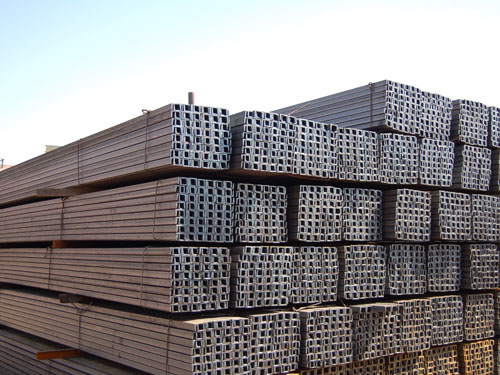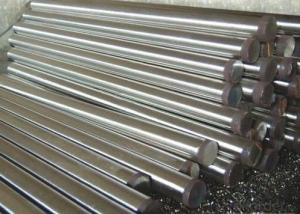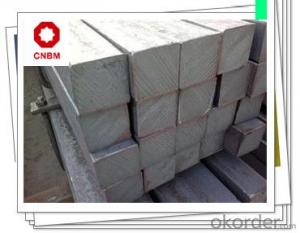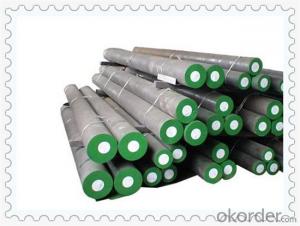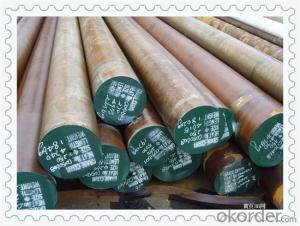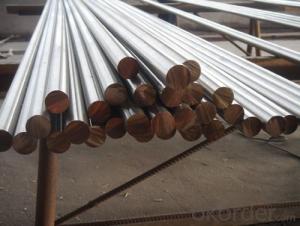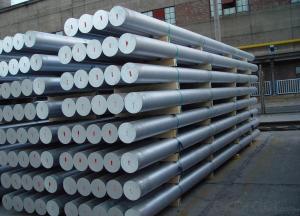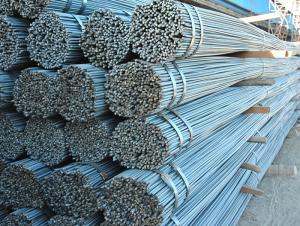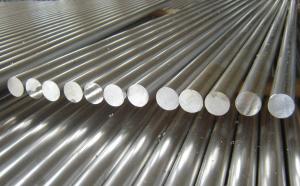Round Steel Bar 5MM-100MM Q195 Q235 Hot Rolled High Quality
- Loading Port:
- China Main Port
- Payment Terms:
- TT or LC
- Min Order Qty:
- -
- Supply Capability:
- -
OKorder Service Pledge
OKorder Financial Service
You Might Also Like
Product Description:
OKorder is offering high quality Hot Rolled Steel I-Beams at great prices with worldwide shipping. Our supplier is a world-class manufacturer of steel, with our products utilized the world over. OKorder annually supplies products to European, North American and Asian markets. We provide quotations within 24 hours of receiving an inquiry and guarantee competitive prices.
Product Applications:
Deformed bar is widely used in buildings, bridges, roads and other engineering construction. Big to highways, railways, bridges, culverts, tunnels, public facilities such as flood control, dam, small to housing construction, beam, column, wall and the foundation of the plate, deformed bar is an integral structure material. With the development of world economy and the vigorous development of infrastructure construction, real estate, the demand for deformed bar will be larger and larger
Product Advantages:
OKorder's Steel I-Beams are durable, strong, and resist corrosion, exact size, regular package, chemical and mechanical properties are stable.
Main Product Features:
· Premium quality
· Prompt delivery & seaworthy packing (30 days after receiving deposit)
· Corrosion resistance
· Can be recycled and reused
· Mill test certification
· Professional Service
· Competitive pricing
Product Specifications:
Manufacture: Hot rolled
Grade: BS4449
Certificates: ISO, SGS, BV, CIQ
Diameter: 6mm,8mm,10mm,12mm,14mm,16mm,18mm,20mm,
22mm,25mm,28mm,32mm,36mm,40mm,50mm
Length: 6M, 9M,12M or as required
Packaging: Export packing, nude packing, bundled
Chemical Composition: (Please kindly find our chemistry of our material based on HRB500 as below for your information)
Grade | Technical data of the original chemical composition (%) | ||||||
C | Mn | Si | S | P | V | ||
HRB400 | ≤0.25 | ≤1.60 | ≤0.80 | ≤0.045 | ≤0.045 | 0.04-0.12 | |
Physical capability | |||||||
Yield Strength (N/cm²) | Tensile Strength (N/cm²) | Elongation (%) | |||||
≥400 | ≥570 | ≥14 | |||||
Theoretical weight and section area of each diameter as below for your information:
Diameter(mm) | Section area (mm²) | Mass(kg/m) | Weight of 12m bar(kg) |
6 | 28.27 | 0.222 | 2.664 |
8 | 50.27 | 0.395 | 4.74 |
10 | 78.54 | 0.617 | 7.404 |
12 | 113.1 | 0.888 | 10.656 |
14 | 153.9 | 1.21 | 14.52 |
16 | 201.1 | 1.58 | 18.96 |
18 | 254.5 | 2.00 | 24 |
20 | 314.2 | 2.47 | 29.64 |
22 | 380.1 | 2.98 | 35.76 |
25 | 490.9 | 3.85 | 46.2 |
28 | 615.8 | 4.83 | 57.96 |
32 | 804.2 | 6.31 | 75.72 |
36 | 1018 | 7.99 | 98.88 |
40 | 1257 | 9.87 | 118.44 |
50 | 1964 | 15.42 | 185.04 |
FAQ:
Q1: How do we guarantee the quality of our products?
A1: We have established an advanced quality management system which conducts strict quality tests at every step, from raw materials to the final product. At the same time, we provide extensive follow-up service assurances as required.
Q2: What makes stainless steel stainless?
A2: Stainless steel must contain at least 10.5 % chromium. It is this element that reacts with the oxygen in the air to form a complex chrome-oxide surface layer that is invisible but strong enough to prevent further oxygen from "staining" (rusting) the surface. Higher levels of chromium and the addition of other alloying elements such as nickel and molybdenum enhance this surface layer and improve the corrosion resistance of the stainless material.
Q3: How soon can we receive the product after purchase?
A3: Within three days of placing an order, we will begin production. The specific shipping date is dependent upon international and government factors, but is typically 7 to 10 workdays.
.

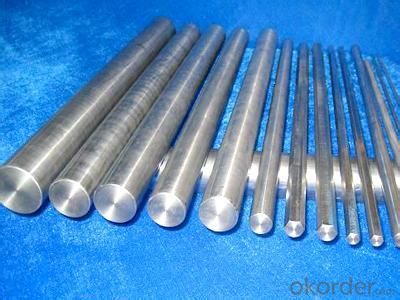
- Q: What are the advantages of using nickel-chromium-cobalt alloy steel round bars?
- There are several advantages of using nickel-chromium-cobalt alloy steel round bars. Firstly, this type of alloy steel has excellent corrosion resistance properties. It can withstand extreme environments, such as high temperatures, humidity, and exposure to chemicals, without succumbing to rust or corrosion. This makes it ideal for applications in industries like aerospace, marine, and chemical processing, where durability and longevity are crucial. Secondly, nickel-chromium-cobalt alloy steel round bars possess exceptional strength and toughness. They have a high tensile strength and can withstand heavy loads and impacts without deforming or breaking. This makes them suitable for applications that require structural integrity and resistance to deformation, such as in the construction industry or in manufacturing heavy machinery. Moreover, this alloy steel exhibits excellent heat resistance. It can withstand elevated temperatures without losing its mechanical properties, making it ideal for applications that involve high-temperature environments, such as in power generation, oil and gas exploration, or furnace components. Additionally, nickel-chromium-cobalt alloy steel round bars offer good wear resistance. They can withstand abrasive conditions, such as friction and wear, without experiencing significant deterioration. This makes them suitable for applications like tooling, machining, and wear components, where durability and resistance to wear are critical. Lastly, nickel-chromium-cobalt alloy steel round bars are highly versatile. They can be easily machined, welded, and formed into various shapes, making them adaptable to a wide range of applications. Their versatility allows for customization and flexibility in design and manufacturing processes. In conclusion, the advantages of using nickel-chromium-cobalt alloy steel round bars include excellent corrosion resistance, high strength and toughness, heat resistance, good wear resistance, and versatility. These qualities make them a preferred choice for various industries, where reliability, durability, and performance are essential.
- Q: What are the advantages of using steel round bars over other materials?
- There are several advantages to using steel round bars over other materials: 1. Strength and durability: Steel round bars are known for their high strength and durability, making them suitable for various applications. They can withstand heavy loads and resist deformation, making them ideal for structural purposes. 2. Versatility: Steel round bars come in a wide range of sizes, grades, and finishes, making them highly versatile. They can be easily customized to meet specific requirements, such as different lengths, diameters, and surface finishes. 3. Cost-effective: Steel round bars offer a cost-effective solution compared to other materials. Their abundance and efficient manufacturing processes make them readily available and affordable. Additionally, their high strength-to-weight ratio allows for the use of smaller quantities of steel while achieving the same level of strength. 4. Corrosion resistance: Steel round bars can be produced with different finishes, including galvanized or stainless steel, which enhances their resistance to corrosion. This makes them suitable for outdoor applications or in environments where they may come into contact with moisture or chemicals. 5. Machinability: Steel round bars are known for their excellent machinability, meaning they can be easily cut, drilled, or shaped to meet specific design requirements. This characteristic allows for efficient processing and reduces production costs. 6. Fire resistance: Steel is inherently fire-resistant and does not contribute to the spread of flames. This makes steel round bars a preferred choice in applications where fire safety is a concern, such as in construction or industrial settings. 7. Recyclability: Steel is highly recyclable, which makes steel round bars an environmentally friendly option. They can be easily melted down and reused to create new steel products without losing their properties or strength. Overall, the advantages of using steel round bars over other materials include their strength, durability, versatility, cost-effectiveness, corrosion resistance, machinability, fire resistance, and recyclability. These factors make steel round bars a preferred choice in various industries, including construction, manufacturing, automotive, and infrastructure projects.
- Q: How do you calculate the length of a steel round bar?
- To calculate the length of a steel round bar, you need to measure its diameter and then use a simple formula involving the diameter and the mathematical constant pi (π). First, use a caliper or a measuring tape to measure the diameter of the steel round bar at its widest point. Make sure to measure across the center of the bar for an accurate result. Once you have the diameter, you can calculate the circumference of the round bar by multiplying the diameter by pi (π). The formula to calculate the circumference is: Circumference = π × Diameter Finally, to determine the length of the round bar, you either need to know the number of complete rotations it makes or measure the distance covered by it. If you know the number of rotations, multiply the circumference by the number of rotations. If you are measuring the distance covered, simply use the measured distance as the length of the round bar.
- Q: What are the different methods of cutting steel round bars?
- Cutting steel round bars can be achieved through several methods, each with their own advantages and limitations. Among the commonly utilized techniques are: 1. Abrasive cutting: By utilizing a rotating abrasive wheel, the steel round bar can be ground down. Despite its speed and efficiency, this method often results in a rough cut surface and generates significant heat. 2. Bandsaw cutting: Steel round bars can be sliced using bandsaw machines, which feature a continuous band of toothed metal rotating around two wheels. Although bandsaws provide precise and smooth cuts, they tend to be slower compared to alternative methods. 3. Cold saw cutting: Cold saws are designed specifically for cutting metal, including steel round bars. These saws employ circular blades with teeth that are specially crafted to withstand the hardness of steel. While cold saws guarantee clean and accurate cuts, they generally operate at a slower pace than abrasive or bandsaw cutting. 4. Plasma cutting: Ideal for thicker steel round bars, plasma cutting involves using a focused jet of ionized gas to melt and remove the metal. This method yields precise and clean cuts, but necessitates specialized equipment and can be more costly than other techniques. 5. Laser cutting: Laser cutting employs a high-powered laser beam to melt and vaporize the metal, resulting in precise and clean cuts. This versatile method can be utilized for steel round bars of varying thicknesses, but it does require expensive equipment and may not be suitable for all applications. Ultimately, the chosen cutting method relies on several factors, including the thickness and hardness of the steel round bar, the desired cut quality, the availability of equipment, and the specific project requirements.
- Q: How are steel round bars used in the construction of dams and reservoirs?
- Steel round bars are essential components in the construction of dams and reservoirs due to their strength, durability, and versatility. These bars, typically made of reinforced steel, play a crucial role in reinforcing the concrete structures that make up dams and reservoirs. One of the primary uses of steel round bars in dam construction is as reinforcement in concrete walls and foundations. The bars are strategically placed within the concrete to provide additional tensile strength, preventing cracking and ensuring structural integrity. The reinforcement helps withstand the enormous pressure exerted by the water, preventing leaks or potential failures. Moreover, steel round bars are utilized to strengthen the spillway gates and control structures of dams and reservoirs. These gates are responsible for regulating the flow of water and preventing overflow during heavy rains or floods. By reinforcing these critical areas with steel round bars, engineers can ensure that the gates can withstand the forces exerted by the flowing water, maintaining their functionality and preventing any potential damage. Additionally, steel round bars are employed in the construction of penstocks, which are large pipes or conduits that carry water from the reservoirs to the turbines in hydroelectric power plants. These bars reinforce the penstocks, ensuring they can withstand the high pressure of the water as it flows through and powers the turbines. In summary, steel round bars are widely used in the construction of dams and reservoirs to enhance the strength and durability of various structural components. Their ability to reinforce concrete walls, foundations, spillway gates, control structures, and penstocks makes them indispensable in ensuring the longevity and stability of these vital water infrastructures.
- Q: What is the difference between a hot-rolled and a forged steel round bar?
- The main difference between a hot-rolled and a forged steel round bar lies in the manufacturing process. Hot-rolled steel bars are produced by heating a billet or ingot and then rolling it into the desired shape, resulting in a smooth surface and consistent dimensions. On the other hand, forged steel round bars are formed through the application of high pressure and localized heating, which creates a stronger and more durable product. Due to the forging process, forged steel round bars often have a rougher surface texture but possess superior mechanical properties compared to hot-rolled steel bars.
- Q: What are the different types of heat treatments applied to steel round bars?
- Steel round bars can undergo various heat treatments to enhance their mechanical properties and improve their performance in different applications. Some commonly used heat treatments include: 1. Annealing: Steel round bars are heated to a specific temperature and then slowly cooled. This process relieves internal stresses, improves ductility, and increases toughness. 2. Normalizing: Steel round bars are heated above the critical transformation point and then cooled in still air. Normalizing improves the structure and mechanical properties of the steel, making it more uniform and reducing residual stresses. 3. Quenching: Steel round bars are rapidly cooled by immersing them in a quenching medium like oil or water. This heat treatment transforms the austenite phase into martensite, increasing the hardness and strength of the steel. 4. Tempering: After quenching, the hardened steel round bars are reheated to a specific temperature and slowly cooled. Tempering reduces brittleness and improves toughness and ductility while maintaining an appropriate level of hardness. 5. Stress Relieving: This heat treatment is used to reduce residual stresses in the steel round bars that may have been introduced during previous manufacturing processes. The bars are heated to a temperature below the transformation point and slowly cooled. Stress relieving improves dimensional stability and reduces the risk of distortion or cracking. 6. Case Hardening: Carbon or nitrogen is introduced into the outer layer of the steel round bars, creating a hard and wear-resistant surface while maintaining a tough and ductile core. These examples illustrate the different heat treatments that can be applied to steel round bars. The choice of heat treatment depends on the desired mechanical properties and specific application requirements.
- Q: Are steel round bars suitable for use in the oil and gas industry?
- Steel round bars are well-suited for the oil and gas industry due to their strength, durability, and high resistance to corrosion. They can withstand the challenging and harsh environments encountered in this industry, making them reliable for critical components such as drilling tools, valves, pipelines, and offshore structures. In the oil and gas industry, extreme temperatures, pressures, and corrosive substances are present in offshore rigs, refining facilities, and pipelines. Steel round bars can withstand these conditions and maintain their structural integrity, making them a reliable choice for critical components. Steel round bars also offer versatility as they can be easily machined, welded, and fabricated into different shapes and sizes. This flexibility is crucial in the oil and gas industry, which often requires unique and complex equipment. Moreover, steel round bars possess excellent mechanical properties such as high tensile strength and impact resistance. These properties are essential for withstanding heavy loads and dynamic forces associated with oil and gas operations, ensuring the safety and reliability of equipment and structures. Additionally, steel round bars have a high resistance to corrosion, which is vital in the oil and gas industry due to the presence of corrosive substances like hydrogen sulfide and saltwater. This corrosion resistance ensures the longevity and reliability of equipment, reducing maintenance costs and downtime. In conclusion, steel round bars are a suitable choice for the oil and gas industry due to their strength, durability, corrosion resistance, and versatility. They are ideal for various applications, ensuring the safe and efficient operation of equipment and structures in this demanding industry.
- Q: What are the differences between hot rolled stainless steel rounds and cold drawn round ones?
- Round bar is divided into three parts: hot rolling, forging and cold drawing. Standard Specification for hot rolled round steel is 5.5-250 mm. Where: 5.5-25 mm small round steel mostly straight bundles of supply, used for steel, bolts and various mechanical parts; greater than 25 mm round steel, seamless steel pipe is mainly used for the manufacture of mechanical parts of the tube, etc..
- Q: What are the different shapes available for steel round bars?
- Steel round bars come in various shapes to cater to different applications. Some of the most common shapes include: 1. Round: The round shape is the most fundamental and widely used for steel round bars. It has a cylindrical form with a circular cross-section. Round bars find applications in multiple industries, including construction, automotive, and manufacturing. 2. Square: Square steel round bars possess a square cross-section. They are frequently employed in situations that demand additional strength and stability, such as support columns, fences, and ornamental ironwork. 3. Hexagonal: Hexagonal steel round bars feature six sides and a hexagonal cross-section. They provide a desirable combination of strength and versatility, making them popular for machine parts, fasteners, and tooling. 4. Flat: Flat steel round bars have a rectangular cross-section with a narrow width and thick height. They are commonly utilized in construction and manufacturing for purposes such as braces, brackets, and supports. 5. Half-round: Half-round steel round bars exhibit a semi-circular cross-section. They are commonly utilized in architectural and decorative applications like handrails, edging, and trim work. These represent some of the most prevalent shapes available for steel round bars. The choice of shape depends on the specific requirements of the application, including strength, stability, and aesthetics.
Send your message to us
Round Steel Bar 5MM-100MM Q195 Q235 Hot Rolled High Quality
- Loading Port:
- China Main Port
- Payment Terms:
- TT or LC
- Min Order Qty:
- -
- Supply Capability:
- -
OKorder Service Pledge
OKorder Financial Service
Similar products
Hot products
Hot Searches
Related keywords



